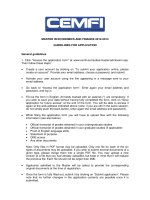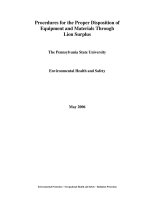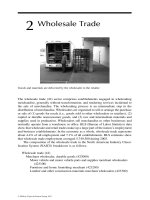Thermodynamics for physicists, chemists and materials scientists 2014
Bạn đang xem bản rút gọn của tài liệu. Xem và tải ngay bản đầy đủ của tài liệu tại đây (5.5 MB, 309 trang )
Undergraduate Lecture Notes in Physics
Reinhard Hentschke
Thermodynamics
For Physicists, Chemists and Materials
Scientists
Uploaded by:
Ebooks Chemical Engineering
/>
For More Books, softwares & tutorials Related to Chemical Engineering
Join Us
@facebook: />@facebook: />@facebook: />
ADMIN:
I.W
Undergraduate Lecture Notes in Physics
For further volumes:
/>
Undergraduate Lecture Notes in Physics (ULNP) publishes authoritative texts
covering topics throughout pure and applied physics. Each title in the series is
suitable as a basis for undergraduate instruction, typically containing practice
problems, worked examples, chapter summaries, and suggestions for further
reading.
ULNP titles must provide at least one of the following:
• An exceptionally clear and concise treatment of a standard undergraduate
subject.
• A solid undergraduate-level introduction to a graduate, advanced, or non-standard subject.
• A novel perspective or an unusual approach to teaching a subject.
ULNP especially encourages new, original, and idiosyncratic approaches to
physics teaching at the undergraduate level.
The purpose of ULNP is to provide intriguing, absorbing books that will continue
to be the reader’s preferred reference throughout their academic career.
Series Editors
Neil Ashby
Professor, Professor Emeritus, University of Colorado Boulder, Boulder, CO, USA
William Brantley
Professor, Furman University, Greenville, SC, USA
Michael Fowler
Professor, University of Virginia, Charlottesville, VA, USA
Michael Inglis
Professor, SUNY Suffolk County Community College, Selden, NY, USA
Elena Sassi
Professor, University of Naples Federico II, Naples, Italy
Helmy S. Sherif
Professor, University of Alberta, Edmonton, AB, Canada
Reinhard Hentschke
Thermodynamics
For Physicists, Chemists and Materials
Scientists
123
Reinhard Hentschke
Bergische Universität
Wuppertal
Germany
ISSN 2192-4791
ISBN 978-3-642-36710-6
DOI 10.1007/978-3-642-36711-3
ISSN 2192-4805 (electronic)
ISBN 978-3-642-36711-3 (eBook)
Springer Heidelberg New York Dordrecht London
Library of Congress Control Number: 2013938033
Ó Springer-Verlag Berlin Heidelberg 2014
This work is subject to copyright. All rights are reserved by the Publisher, whether the whole or part of
the material is concerned, specifically the rights of translation, reprinting, reuse of illustrations,
recitation, broadcasting, reproduction on microfilms or in any other physical way, and transmission or
information storage and retrieval, electronic adaptation, computer software, or by similar or dissimilar
methodology now known or hereafter developed. Exempted from this legal reservation are brief
excerpts in connection with reviews or scholarly analysis or material supplied specifically for the
purpose of being entered and executed on a computer system, for exclusive use by the purchaser of the
work. Duplication of this publication or parts thereof is permitted only under the provisions of
the Copyright Law of the Publisher’s location, in its current version, and permission for use must
always be obtained from Springer. Permissions for use may be obtained through RightsLink at the
Copyright Clearance Center. Violations are liable to prosecution under the respective Copyright Law.
The use of general descriptive names, registered names, trademarks, service marks, etc. in this
publication does not imply, even in the absence of a specific statement, that such names are exempt
from the relevant protective laws and regulations and therefore free for general use.
While the advice and information in this book are believed to be true and accurate at the date of
publication, neither the authors nor the editors nor the publisher can accept any legal responsibility for
any errors or omissions that may be made. The publisher makes no warranty, express or implied, with
respect to the material contained herein.
Printed on acid-free paper
Springer is part of Springer Science+Business Media (www.springer.com)
Preface
Many of us associate thermodynamics with blotchy photographs of men in oldfashioned garments posing in front of ponderous steam engines. In fact thermodynamics was developed mainly as a framework for understanding the relation
between heat and work and how to convert heat into mechanical work efficiently.
Nevertheless, the premises or laws from which thermodynamics is developed are
so general that they provide insight far beyond steam engine engineering. Today
new sources of useful energy, energy storage, transport, and conversion, requiring
development of novel technology, are of increasing importance. This development
strongly affects many key industries. Thus, it seems that thermodynamics will have
to be given more prominence particularly in the physics curriculum—something
that is attempted in this book.
Pure thermodynamics is developed, without special reference to the atomic or
molecular structure of matter, on the basis of bulk quantities like internal energy,
heat, and different types of work, temperature, and entropy. The understanding of
the latter two is directly rooted in the laws of thermodynamics—in particular the
second law. They relate the above quantities and others derived from them. New
quantities are defined in terms of differential relations describing material properties like heat capacity, thermal expansion, compressibility, or different types of
conductance. The final result is a consistent set of equations and inequalities.
Progress beyond this point requires additional information. This information
usually consists in empirical findings like the ideal gas law or its improvements,
most notably the van der Waals theory, the laws of Henry, Raoult, and others. Its
ultimate power, power in the sense that it explains macroscopic phenomena
through microscopic theory, thermodynamics attains as part of Statistical
Mechanics or more generally Many-body Theory.
The structure of this text is kept simple in order to make the succession of steps
as transparent as possible. The first chapter (Two Fundamental Laws of Nature)
explains how the first and the second law of thermodynamics can be cast into a
useful mathematical form. It also explains different types of work as well as concepts like temperature and entropy. The final result is the differential entropy
change expressed through differential changes in internal energy and the various
types of work. This is a fundamental relation throughout equilibrium as well as nonequilibrium thermodynamics. The second chapter (Thermodynamic Functions),
v
vi
Preface
aside from introducing most of the functions used in thermodynamics, in particular
internal energy, enthalpy, Helmholtz, and Gibbs free energy, contains examples
allowing to practice the development and application of numerous differential
relations between thermodynamic functions. The discussion includes important
concepts like the relation of the aforementioned free energies to the second law,
extensiveness, and intensiveness as well as homogeneity. In the third chapter
(Equilibrium and Stability) the maximum entropy principle is explored systematically. The phase concept is developed together with a framework for the
description of stability of phases and phase transitions. The chemical potential is
highlighted as a central quantity and its usefulness is demonstrated with a number
of applications. The fourth chapter (Simple Phase Diagrams) focuses on the calculation of simple phase diagrams based on the concept of interacting molecules.
Here the description is still phenomenological. Equations, rules, and principles
developed thus far are combined with van der Waals’ picture of molecular interaction. As a result a qualitative theory for simple gases and liquids emerges. This is
extended to gas and liquid mixtures as well as to macromolecular solutions, melts,
and mixtures based on ideas due to Flory and others. The subsequent chapter
(Microscopic Interactions) explains how the exact theory of microscopic interactions can be combined with thermodynamics. The development is based on Gibbs’
ensemble picture. Different ensembles are introduced and their specific uses are
discussed. However, it also becomes clear that exactness usually is not a realistic
goal due to the enormous complexity. In the sixth chapter (Thermodynamics and
Molecular Simulation) it is shown how necessary and crude approximations
sometimes can be avoided with the help of computers. Computer algorithms may
even allow tackling problems eluding analytical approaches. This chapter therefore
is devoted to an introduction of the Metropolis Monte Carlo method and its
application in different ensembles. Thus far the focus has been equilibrium thermodynamics. The last chapter (Non-equilibrium Thermodynamics) introduces
concepts in non-equilibrium thermodynamics. The starting point is linear irreversible transport described in terms of small fluctuations close to the equilibrium
state. Onsager’s reciprocity relations are obtained and their significance is illustrated in various examples. Entropy production far from equilibrium is discussed
based on the balance equation approach and the concept of local equilibrium. The
formation of dissipative structures is discussed focusing on chemical reactions. This
chapter also includes a brief discussion of evolution in relation to non-equilibrium
thermodynamics. There are several appendices. Appendix A: Thermodynamics
does not require much math. Most of the necessary machinery is compiled in this
short appendix. The reason that thermodynamics is often perceived difficult is not
because of its difficult mathematics. It is because of the physical understanding and
meticulous care required when mathematical operations are carried out under
constraints imposed by process conditions. Appendix B: The appendix contains a
listing of a Grand-Canonical Monte Carlo algorithm in Mathematica. The interested
reader may use this program to recreate results presented in the text in the context of
equilibrium adsorption. Appendix C: This appendix compiles constants, units, and
references to useful tables. Appendix D: References are included in the text and as a
Preface
vii
separate list in this appendix. Of course, there are other texts on Thermodynamics
or Statistical Thermodynamics, which are nice and valuable sources of information—even if or because some of them have been around for a long time. A selected
list is contained in a footnote on page 16. Another listing can be found in the preface
to Hill (1986).
Wuppertal, Germany
Reinhard Hentschke
Contents
Fundamental Laws of Nature . . . . . .
Types of Work . . . . . . . . . . . . . . . . .
The Postulates of Kelvin and Clausius .
Carnot’s Engine and Temperature . . . .
Entropy . . . . . . . . . . . . . . . . . . . . . .
.
.
.
.
.
.
.
.
.
.
.
.
.
.
.
.
.
.
.
.
.
.
.
.
.
.
.
.
.
.
.
.
.
.
.
.
.
.
.
.
.
.
.
.
.
.
.
.
.
.
.
.
.
.
.
.
.
.
.
.
.
.
.
.
.
.
.
.
.
.
.
.
.
.
.
.
.
.
.
.
.
.
.
.
.
.
.
.
.
.
1
1
15
16
22
.
.
.
.
.
.
.
.
.
.
.
.
.
.
.
.
.
.
.
.
.
.
.
.
.
.
.
.
.
.
.
.
.
.
.
.
.
.
.
.
.
.
.
.
.
.
.
.
.
.
.
.
.
.
.
.
.
.
.
.
.
.
.
.
.
.
.
.
.
.
.
.
.
.
.
.
.
.
.
.
.
.
.
.
.
.
.
.
.
.
27
27
29
54
68
3
Equilibrium and Stability. . . . . . . . . . . . . . . . . . . .
3.1 Equilibrium and Stability via Maximum Entropy.
3.2 Chemical Potential and Chemical Equilibrium . .
3.3 Applications Involving Chemical Equilibrium . . .
.
.
.
.
.
.
.
.
.
.
.
.
.
.
.
.
.
.
.
.
.
.
.
.
.
.
.
.
.
.
.
.
.
.
.
.
.
.
.
.
.
.
.
.
73
73
80
90
4
Simple Phase Diagrams . . . . . . . . . . . . . . . . . .
4.1 Van Der Waals Theory . . . . . . . . . . . . . . .
4.2 Beyond Van Der Waals Theory. . . . . . . . . .
4.3 Low Molecular Weight Mixtures. . . . . . . . .
4.4 Phase Equilibria in Macromolecular Systems
.
.
.
.
.
.
.
.
.
.
.
.
.
.
.
.
.
.
.
.
.
.
.
.
.
.
.
.
.
.
.
.
.
.
.
.
.
.
.
.
.
.
.
.
.
.
.
.
.
.
.
.
.
.
.
.
.
.
.
.
.
.
.
.
.
.
.
.
.
.
125
125
140
155
164
5
Microscopic Interactions . . . . . . . . . . .
5.1 The Canonical Ensemble . . . . . . . .
5.2 Generalized Ensembles. . . . . . . . . .
5.3 Grand-Canonical Ensemble. . . . . . .
5.4 The Third Law of Thermodynamics.
.
.
.
.
.
.
.
.
.
.
.
.
.
.
.
.
.
.
.
.
.
.
.
.
.
.
.
.
.
.
.
.
.
.
.
.
.
.
.
.
.
.
.
.
.
.
.
.
.
.
.
.
.
.
.
.
.
.
.
.
.
.
.
.
.
.
.
.
.
.
.
.
.
.
.
.
.
.
.
.
.
.
.
.
.
173
173
201
205
217
6
Thermodynamics and Molecular Simulation .
6.1 Metropolis Sampling . . . . . . . . . . . . . . .
6.2 Sampling Different Ensembles . . . . . . . .
6.3 Selected Applications . . . . . . . . . . . . . . .
.
.
.
.
.
.
.
.
.
.
.
.
.
.
.
.
.
.
.
.
.
.
.
.
.
.
.
.
.
.
.
.
.
.
.
.
.
.
.
.
.
.
.
.
.
.
.
.
.
.
.
.
.
.
.
.
.
.
.
.
.
.
.
.
221
221
225
227
1
Two
1.1
1.2
1.3
1.4
2
Thermodynamic Functions . . . . . . . . .
2.1 Internal Energy and Enthalpy . . . .
2.2 Simple Applications. . . . . . . . . . .
2.3 Free Energy and Free Enthalpy . . .
2.4 Extensive and Intensive Quantities
.
.
.
.
.
.
.
.
.
.
.
.
.
.
.
.
.
.
.
.
.
.
.
.
.
.
.
.
.
.
ix
x
Contents
.
.
.
.
.
239
240
250
263
273
Appendix A: The Mathematics of Thermodynamics . . . . . . . . . . . . . .
281
Appendix B: Grand-Canonical Monte Carlo:
Methane on Graphite . . . . . . . . . . . . . . . . . . . . . . . . . .
289
Appendix C: Constants, Units, Tables . . . . . . . . . . . . . . . . . . . . . . . .
293
Index . . . . . . . . . . . . . . . . . . . . . . . . . . . . . . . . . . . . . . . . . . . . . . . .
299
7
Non-Equilibrium Thermodynamics . . .
7.1 Linear Irreversible Transport. . . . .
7.2 Entropy Production . . . . . . . . . . .
7.3 Complexity in Chemical Reactions
7.4 Remarks on Evolution . . . . . . . . .
.
.
.
.
.
.
.
.
.
.
.
.
.
.
.
.
.
.
.
.
.
.
.
.
.
.
.
.
.
.
.
.
.
.
.
.
.
.
.
.
.
.
.
.
.
.
.
.
.
.
.
.
.
.
.
.
.
.
.
.
.
.
.
.
.
.
.
.
.
.
.
.
.
.
.
.
.
.
.
.
.
.
.
.
.
.
.
.
.
.
.
.
.
.
.
.
.
.
.
.
Chapter 1
Two Fundamental Laws of Nature
1.1 Types of Work
1.1.1 Mechanical Work
A gas confined to a cylinder absorbs a certain amount of heat, δq. The process is
depicted in Fig. 1.1. According to experimental experience this leads to an expansion
of the gas. The expanding gas moves a piston to increase its volume by an amount
δV = Vb − Va . For simplicity we assume that the motion of the piston is frictionless
and that its mass is negligible compared to the mass, m, of the weight pushing down
on the piston. We do not yet have a clear understanding of what heat is, but we
consider it a form of energy which to some extend can be converted into mechanical
work, w.1 In our case this is the work needed to lift the mass, m, by a height, δs,
against the gravitational force m g. From mechanics we know
b
δwdone by gas =
b
ds · f gas = −
a
ds · m g
a
= Pex
Vb
d V = Pex δV.
Va
Here Pex = mg/A is the external pressure exerted on the gas due to the force mg
acting on the cross-sectional area, A (δV = Aδs).
The process just described leads to a change in the total energy content of the gas,
δ E. The gas receives a positive amount of heat, δq. However, during the expansion
it also does work and thereby reduces its total energy content, in the following called
1
Originally it was thought that heat is a sort of fluid and heat transfer is transfer of this fluid. In
addition, it was assumed that the overall amount of this fluid is conserved. Today we understand
that heat is a form of dynamical energy due to the disordered motion of microscopic particles and
that heat can be changed into other forms of energy. This is what we need to know at this point. The
microscopic level will be addressed in Chap. 5.
R. Hentschke, Thermodynamics, Undergraduate Lecture Notes in Physics,
DOI: 10.1007/978-3-642-36711-3_1, © Springer-Verlag Berlin Heidelberg 2014
1
2
1 Two Fundamental Laws of Nature
mg
b
mg
a
s
q
Fig. 1.1 A gas confined to a cylinder absorbs a certain amount of heat, δq
internal energy, by −Pex δV . The combined result is
δ E = δq − Pex δV.
Notice that after the expansion has come to an end we have Pex = P, where P
is the gas pressure inside the cylinder. In particular we know that P is a function of
the volume, V , occupied by the gas, i.e. P = P(V ). In the following we assume that
the change in gas pressure during a small volume change δV is a second order effect
which can be neglected. Therefore for small volume changes we have
δ E = δq − PδV.
(1.1)
This is the first law of thermodynamics for this special process. It uses energy conservation to distinguish the different contributions to the total change in internal energy
of a system (here the gas) during a thermodynamic process (here absorption of heat
plus volume expansion).
We just have introduced two important concepts frequently used in thermodynamics—process and system. The latter requires the ability to define a boundary between
“inside” and “outside”. Both, the inside and the outside, may be considered systems
individually. Systems usually are distinguished according to their degree of openness.
Isolated system means that this system exchanges nothing with its exterior. An open
system on the other hand may exchange everything there is to exchange, like heat or
matter. A closed system holds back matter but allows heat exchange, e.g. the above
gas filled cylinder. Systems are sometimes divided into subsystems. Subsystems,
however, are still systems. After having defined or (better) prepared a system we
may observe what happens to it or we may actively do something to it. This “what
1.1 Types of Work
3
happens to it” or “doing something” means that the system undergoes a process
(of change). A special type of system is the reservoir. A reservoir usually is in
thermal contact with our system of interest. Thermal contact means that heat may be
transferred between the reservoir and our system of interest. However, the reservoir
is so large that there is no measurable change in any of its physical properties due to
the exchange.
Now we proceed replacing the above gas by an elastic medium. Those readers
who are not sufficiently familiar with the theory of elastic bodies may skip ahead to
“Electric work” (p. 7).
Mechanical Work Involving Elastic Media
We consider an elastic body composed of volume elements d V depicted in Fig. 1.2.
The total force acting on the elastic body may be calculated according to
V
d V fα
(1.2)
for every component α (= 1, 2, 3 or x, y, z). Here f is a force density, i.e. force per
volume. Assuming that the f α are purely elastic forces acting between the boundaries
of the aforementioned volume elements inside V , i.e. excluding for instance gravitational forces or other external fields acting on volume elements inside the elastic
body, we may define the internal stress tensor, σ , via
3
fα =
β=1
∂σαβ
∂σαβ
≡
.
∂ xβ
∂ xβ
(1.3)
Fig. 1.2 Elastic body composed of volume elements d V
dV
V
4
1 Two Fundamental Laws of Nature
x
shear force on -face / area
V
normal force on -face / area
x
Fig. 1.3 The relation between indices, force components, and the faces of the cubic volume element
Here we apply the summation convention, i.e. if the same index appears twice on
the same side of an equation then summation over this index is implicitly assumed
(unless explicitly stated otherwise). The relation between indices, force components,
and the faces of the cubic volume element is depicted in Fig. 1.3. Upper and lower
sketches illustrate the shear and the normal contribution to the force component f α
acting on the volume element in α-direction. Notice that f α can be written as the
sum over two shear stress and one normal stress contribution. The latter are stress
differences between adjacent faces of the cubic volume element. Note also that the
unit of σαβ is force per area.
We want to calculate the work δw done by the f α during attendant small displacements δu α , i.e.
∂σαβ
(1.3)
δw = d V f α δu α =
dV
δu α .
∂ xβ
The integral may be rewritten using Green’s theorem in space:
δw =
σαβ δu α d Aβ −
d V σαβ
∂δu α
.
∂ xβ
1.1 Types of Work
5
We neglect the surface contribution2 and use the symmetry property of the stress
tensor3 to obtain
δw = −
d V σαβ
∂δu α
1
=−
∂ xβ
2
d V σαβ δ
∂u β
∂u α
.
+
∂ xβ
∂ xα
∼
=2u αβ
The quantity u αβ is the strain tensor (here for small displacements). The final result is
δw = −
d V σαβ δu αβ .
(1.4)
We want to work this out in three simple cases. First we consider a homogeneous
dilatation of a cubic volume V = L x L y L z . We also assume that the shear components
of the stress tensor vanish, i.e. σαβ = 0 for α = β. In such a system the normal
components of the stress tensor should all be the same, i.e. σ ≡ σx x = σ yy = σzz .
We thus have
σαβ δu αβ = σx x δu x x + σ yy δu yy + σzz δu zz = σ (δu x x + δu yy + δu zz ).
(1.5)
Homogeneous deformation means
δL α
∂u α
=
.
∂ xα
Lα
(1.6)
And because u αα = ∂u α /∂ xα (no summation convention here) we obtain
σαβ δu αβ = σ
δL y
δL x
δL z
+
+
Lx
Ly
Lz
=σ
δV
.
V
(1.7)
Integration over the full volume then yields
2
For a discussion see Landau et al. (1986).
To show the symmetry of the stress tensor, i.e. σαβ = σβα , we compute the torque exerted by the
f α in a particular volume element integrated over the entire body:
3
d V ( f α xβ − f β xα ) =
∂(σαγ xβ − σβγ xα )
−
∂ xγ
=
dV
=
(σαγ xβ − σβγ xα )d Aγ −
dV
∂σβγ
∂σαγ
xβ −
xα
∂ xγ
∂ xγ
d V (σαγ δβγ − σβγ δαγ )
d V (σαβ − σβα ).
The volume integral must vanish in order for the net torque to be entirely due to forces applied to
the surface of the body.
6
1 Two Fundamental Laws of Nature
δw = −σ δV,
(1.8)
i.e. we recover the above gas case with P = −σ .
In a second example we consider the homogeneous dilatation of a thin elastic
sheet. The sheet’s volume is V = Ah = L x L y h, where the thickness, h, is small
and constant. Now we have
σαβ δu αβ = σ
δL y
δL x
+
Lx
Ly
=σ
δA
A
(1.9)
and therefore
δw = −σ hδ A ≡ −γ δ A.
(1.10)
The quantity γ is the surface tension.
An obvious third example is the homogeneous dilatation of a thin elastic column
V = h 2 L z . Here h 2 is the column cross sectional area and L z is its length. This time
we have
δL z
(1.11)
σαβ δu αβ = σ
Lz
and thus
δw = −σ AδL z ≡ −T δL z ,
(1.12)
where T is the tension.
Example: Expanding Gas. We consider the special case of the first law
expressed in Eq. (1.1). If we include the surface tension contribution to the
internal energy of the expanding gas, then the resulting equation is
δ E = δq − PδV + γ δ A.
(1.13)
We remark that the usual context in which one talks about surface tension refers to
interfaces. This may be the interface between two liquids or the surface of a liquid
film relative to air, e.g. a soap bubble. In the latter case there are actually two surfaces.
In such cases we define γ = f T /(2l), which reflects the presence of two surfaces.
Example: Fusing Bubbles. An application of surface tension is depicted in
Fig. 1.4. The figure depicts two soap bubbles touching and fusing. We ask
whether the small bubble empties its gas content into the large one or vice
versa. We may answer this question by considering the work done by one
isolated bubble during a small volume change:
1.1 Types of Work
7
Fig. 1.4 An application of
surface tension
δwdone by gas in bubble = Pex δV + γ δ A.
Notice that the sign of the surface tension contribution has changed compared
to Eq. (1.10). This is because in Eq. (1.10) we compute the work done by the
membrane. But here the gas is doing work on the membrane, which changes
the sign of this work contribution. The same work, i.e. δwdone by gas in bubble ,
can be written in terms of the pressure, P, inside the bubble,
δwdone by gas in bubble = PδV.
Combining the two equations and using δV = 4πr 2 δr and δ A = 8πr δr ,
where r is the bubble radius, yields
P = Pex +
2γ
.
r
We conclude that the gas inside the smaller bubble has the higher pressure and
therefore the smaller bubble empties itself into the larger bubble.
1.1.2 Electric Work
We now consider work involving electric and magnetic variables4,5 starting with an
example.
4
5
Here we use Gaussian units. The conversion to SI-units is tabulated in Appendix C.
Three early but very basic papers in this context are: Guggenheim (1936a, b); Koenig (1937).
8
1 Two Fundamental Laws of Nature
Example: Charge Transfer Across a Potential Drop. A charge δq in an
electric field experiences the force F = δq E (Do not confuse this δq with
the previously introduced heat change!). Consequently the work done by the
charge-field system if the charge moves from point a to point b in space is
b
δwq =
b
ds · F = −δq
a
ds · ∇φ.
(1.14)
a
Here φ is the potential, i.e. E = −∇φ, and thus
δwq = −δqφba ,
(1.15)
where φba = φ(b) − φ(a) is the potential difference between b and a. The
corresponding internal energy of the charge-field system changes by
δ E q = −δwq = δqφba .
(1.16)
This equation may be restated for a charge current I = δq/δt, where δt is a
certain time interval:
(1.17)
δ E I = I φba δt.
In the presence of the resistance, R, the quantity δq J oule = R I 2 δt is the Joule
heat generated by the current (James Prescott Joule, British physicist, *Salford
(near Manchester) 24.12.1818, †Sale (County Cheshire) 11.10.1889; made
important contributions to our understanding of heat in relation to mechanical
work (Joule heat) and internal energy (Joule-Thomson effect).).
Now we consider the following equations appropriate for continuous dielectric
media:
1 ∂
4π
∇×H =
D+
j
(1.18)
c ∂t
c
and
∇×E =−
1 ∂
B.
c ∂t
(1.19)
The second equation simply follows by the usual spatial averaging procedure applied
to the corresponding vacuum Maxwell’s equation.6 Here E(r ) is the average electric
field in a volume element at point r . This volume element is large compared to atomic
dimensions. In the same sense D is the displacement field given by D = E + 4π P.
P is the macroscopic polarization, i.e. the local electrical dipole moment per volume.
Analogously B = H + 4π M is the average magnetic field (magnetic induction),
6
James Clerk Maxwell, British physicist, *Edinburgh 13.6.1831, †Cambridge 5.11.1879; particularly known for his unified theory of electromagnetism (Maxwell equations).
1.1 Types of Work
9
and M is the macroscopic magnetization, i.e. the local magnetic dipole moment per
volume. The first equation is less obvious and requires a more detailed discussion.
We consider a current density je inside a medium due to an extra (“injected”)
charge density ρe . The two quantities fulfill the continuity equation
∂ρe
+ ∇ · je = 0.
∂t
We also have
∇ · D = 4πρe .
Differentiation of this Maxwell equation with respect to time and inserting the result
into the previous equation yields
∇·
∂D
+ 4π je
∂t
= 0.
The expression in brackets is a vector, which may be expressed as the curl of another
vector c H , i.e.
4π
1 ∂D
+
∇×H =
je .
c ∂t
c
Comparison of this with Ampere’s law in vacuum suggests indeed H = H and
c = c. We thus arrive at Eq. (1.18). An in depths discussion can be found in
Lifshitz et al. (2004).
We proceed by multiplying Eq. (1.18) with c E/(4π ) and Eq. (1.19) with
−c H /(4π ). Adding the two equations yields
1
c
∂D
∂B
c
1
+
+ j · E.
E· ∇×H −
H· ∇×E =
E·
H·
4π
4π
4π
∂t
4π
∂t
With the help of the vector identity ∇ · (a × b) = b · (∇ × a) − a · (∇ × b) this is
transformed into
c
1
1
∂D
∂B
+
+ j · E.
∇· H×E =
E·
H·
4π
4π
∂t
4π
∂t
Now we integrate both sides over the volume V and use Green’s theorem in space
(also called divergence theorem), i.e. V d V ∇ · ( H × E) = A d A · ( H × E),
where A is a surface element on the surface A of the volume oriented towards the
outside of V . If we choose the volume so that the fields vanish on its surface, then
A d A · ( H × E) = 0 (The configuration of the system is fixed during all of this.).
Thus our final result is
10
1 Two Fundamental Laws of Nature
Fig. 1.5 A cylindrical volume
element whose axis is parallel
to j
A
j
dV
E·
δB
δD
+H·
+ j · Eδt
4π
4π
= 0.
s
(1.20)
The third term in Eq. (1.20) is the work done by the E-field during the time δt. To
see this we imagine a cylindrical volume element whose axis is parallel to j depicted
in Fig. 1.5. Then δV = Aδs and δV j = (q/δt)δs, where q is the charge passing
through the area A during the time δt. Thus δV j · Eδt = q E · δs, where q E is the
force acting on the charge q doing work (cf. the above example).
We conclude that we may express the work done by the system, δw = d V j· E δt,
by the other two terms in Eq. (1.20) describing the attendant change of the electromagnetic energy content of the system. For a process during which the system exchanges
heat and is doing electrical work we now have
δ E = δq +
dV
E·
δB
δD
+H·
4π
4π
.
(1.21)
The quantities E, D, B, and H are more difficult to deal with than fields in vacuum.
Nevertheless, for the moment we postpone a more detailed discussion and return to
Eq. (1.21) on p. 57.
1.1.3 Chemical Work
As a final example consider an open system—one we can add material to. Generally,
work must be done to increase the amount of material in a system. The work done
depends on the state of the system. If we add δn moles of material,7 we write the
One mole (n = 1) is an amount of substance of a system which contains as many elementary
units as there are atoms of carbon in 12 g of the pure nuclide carbon-12. The elementary unit may
be an atom, molecule, ion, electron, photon, or a specified group of such units.
7
1.1 Types of Work
11
work done on the system as
δwdone on system = μδn.
(1.22)
The quantity μ is called the chemical potential (per mole added). In a more general
situation a system may contain different species. We shall say that these are different
components i. Now the above equation becomes
δwdone on system =
μi δn i .
(1.23)
i
Here μi is the chemical potential of component i. Thus for a process involving
exchange of heat as well as chemical work we have
δ E = δq +
μi δn i .
(1.24)
i
1.1.4 The First Law
The first law is expressing conservation of energy. The specific terms appearing in
the first law do depend on the types of work occurring in the process of interest. The
following box contains a number of examples.
Example: Statements of the First Law for Different Processes.
(i)
δ E = δq − PδV + γ δ A +
μi δn i
i
This describes a process during which heat is exchanged by the system and
its exterior. Mechanical work in the form of volume work and surface work is
done in addition. The composition of the system changes as well.
(ii)
δ E = δq −
d V j · Eδt
Here the process of interest involves heat exchange and electrical work.
12
1 Two Fundamental Laws of Nature
(iii)
δ E = δq − PδV +
dV
E · δD + H · δB
4π
This example is for a process during which heat is exchanged and both volume
and electrical work is done.
More generally the first law is expressed via
δ E = δq − δw.
(1.25)
However, there is an alternative sign convention used in some of the literature, i.e.
δ E = δq + δw.
(1.26)
The sign preceding δw depends on the meaning of the latter. In Eq. (1.25) δw always
is the work done by the system for which we write down the change in the system’s internal energy, δ E, during a process involving both heat transfer and work.
In Eq. (1.26) on the other hand δw is understood as work done on the system. In the
following we shall use the sign convention as expressed in Eq. (1.25)!
Another point worth mentioning is the usage of the symbols δ, , and d. δ denotes
a small change (afterwards–before) during a process. basically has the same meaning, except that the change is not necessarily small. Even though d indicates a small
change just like δ, it has an additional meaning—indicating exact differentials. This
is something we shall discuss in much detail latter in the text. But for the benefit of
those who compare the form of Eq. (1.25) to different texts, we must add a provisional
explanation.
In principle every process has a beginning and an end. Beginning and end, as we
shall learn, are defined in terms of specific values of certain variables (e.g. values of
P and V ). These two sets of variable values can be connected by different processes
or paths in the space in which the variables “live”. If a quantity changes during a
process and this change only depends on the two endpoints of the path rather than
on the path as a whole, then the quantity possesses an exact differential and vice
versa. In the case of mechanical work, for instance, we can imagine pushing a cart
from point A to point B. There may be two alternative routes—one involving a lot
of friction and a “smooth” one causing less friction. In the former case one may find
Eq. (1.25) stated as
d E = δq − δw.
(1.27)
This form explicitly distinguishes between the exact differential d E and the quantities
δq and δw, which are not exact differentials. In the case of δw this is in accord with
our cart-pushing example, because the work does depend on the path we choose.
For the two other quantities we shall show their respective property latter in this text
(cf. p. 283ff), when we deal with the mathematics of exact differentials.
1.1 Types of Work
13
However, already at this point we remark that the expressions we have derived in
our examples for the various types of work will reappear with d instead of δ. This
is because we focus on what we shall call reversible work. Friction, occurring in
the cart-pushing example or possibly in Fig. 1.1 when the gas moves the piston, is
neglected as well as other types of loss. The following is an example illustrating what
we mean by reversible vs. irreversible work.
Example: Reversible and Irreversible Work. In an isotropic elastic body the
following equation holds (Landau et al. 1986):
α=β
σαβ = 2μu αβ = μ
∂u β
∂u α
+
∂ xβ
∂ xα
.
(1.28)
On the right is the stress tensor and on the left the product of 2μ with the
strain tensor (for small strain). The quantity μ is the shear modulus (not to be
confused with the chemical potential). This equation is related to the two upper
sketches in Fig. 1.3. If in the depicted situation (shear force acting on β-face
is applied in α-direction) there is little or ideally no strain in β-direction (this
is like shearing a deck of cards), then the above equation may be written as
σμ ≡ σαβ = μ
∂u α
≡ μu μ .
∂ xβ
(1.29)
Real shear is accompanied by friction. Experience suggests that friction often
can be described by an equation akin to the above:
ση = ηu˙ η .
(1.30)
The quantity η is a friction coefficient and u˙ η is a strain rate. Figure 1.6, showing a spring and a dashpot, is a pictorial representation of Eqs. (1.29) and
(1.30). Figure 1.7 shows three simple combinations (a, b, c) of the two elements depicted in Fig. 1.6. These combinations may be translated into differential equations and serve as simple models for so called viscoelastic behavior
(Wrana 2009). Important viscoelastic materials are the tread compounds in
automobile tires. In the following we merely focus on sketch (a). Its translation is
(u ≡ u μ = u η ).
(1.31)
σ ≡ σμ + ση = μu + ηu˙
We assume that the applied stress is σ = σo sin(ωt +δ), where ω is a frequency,
t is time, and δ is a phase. The attendant strain is u = u o sin(ωt) (This is a
simple mathematical description of an experimental procedure in what is called
14
1 Two Fundamental Laws of Nature
Fig. 1.6 Pictorial representation of Eqs. (1.29) and (1.30)
µ
Fig. 1.7 Three simple combinations (a, b, c) of the two
elements
µ
(a)
(b)
µ
(c)
µ
1
µ
2
dynamic mechanical analysis.). Inserting this into Eq. (1.31) we find the relations
σo cos δ = μu o ≡ μ u o
σo sin δ = ηωu o ≡ μ u o .
(1.32)
(1.33)
The two newly defined quantities μ and μ are called storage and loss modulus, respectively. Their meaning becomes clear if we compute the work done
during one full shear cycle, i.e.
2π/ω
σ du =
0
σ udt
˙ = π μ u 2o .
(1.34)









